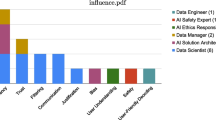Abstract
Despite the fact that machine learning has been applied in innumerable domains, its models have usually operated in a black box fashion, i.e. without revealing the rationale behind their decisions. For human users, insufficient model transparency may result in the lack of trust in the technology, effectively hindering its development and adoption. This pressing need for the society to understand the reasoning for the model’s decisions gave rise to the concept of explainable AI (xAI), which has been the subject of extensive research. Since its introduction, a number of techniques providing explainability have been proposed. Yet, there has been no consensus reached regarding how to measure and evaluate the performance of the explainability methods. So far, the state-of-the-art literature has proposed two directions for evaluating explainable AI–the technical one and the human-centered one. Although the literature deems the technical way to be the objective one, it still suggests supplementing the evaluation with the subjective, human-centered approach, which proves to be time-consuming and requires considerable effort. This paper highlights the need to enhance and improve the existing technical metrics, to quantify the explainability of ML models in an objective, automated and time and cost-effective way. The text presents the current state-of-the-art in xAI evaluation metrics, discussing both human-centered and computer-centered approaches. Its contribution is in its comprehensive discussion of the evaluation methods for explainable AI (xAI).
Access this chapter
Tax calculation will be finalised at checkout
Purchases are for personal use only
Similar content being viewed by others
References
Vouros, G.A.: Explainable deep reinforcement learning: state of the art and challenges. ACM Comput. Surv. 55(5), 1–39 (2022)
Song, H., Kim, S.: Explainable artificial intelligence (xai): how to make image analysis deep learning models transparent. In: 2022 22nd International Conference on Control, Automation and Systems (ICCAS), pp. 1595–1598. IEEE (2022)
Parkinson, M., Carter, J., Nawaz, R.: Leveraging artificial intelligence (AI) to build SMEs’ resilience amid the global Covid-19 pandemic. In: Research and Innovation Forum 2022. RIIFORUM 2022. Springer Proceedings in Complexity, pp. 547–556. Springer, Cham (2023)
Szczepański, M., Choraś, M., Pawlicki, M., Kozik, R.: Achieving explainability of intrusion detection system by hybrid oracle-explainer approach. In: 2020 International Joint Conference on Neural Networks (IJCNN), pp. 1–8. IEEE (2020)
Yu, J., Cristea, A.I., Harit, A., Sun, Z., Aduragba, O.T., Shi, L., Al Moubayed, N.: Interaction: a generative xai framework for natural language inference explanations. In: 2022 International Joint Conference on Neural Networks (IJCNN), pp. 1–8. IEEE (2022)
Zhang, Z., Hamadi, H.A., Damiani, E., Yeun, C.Y., Taher, F.: Explainable artificial intelligence applications in cyber security: state-of-the-art in research (2022). arXiv preprint arXiv:2208.14937
Nomm, S.: Towards the linear algebra based taxonomy of xai explanations (2023). arXiv preprint arXiv:2301.13138
Srikanth, K., Ramesh, T., Palaniswamy, S., Srinivasan, R.: Xai based model evaluation by applying domain knowledge. In: 2022 IEEE International Conference on Electronics, Computing and Communication Technologies (CONECCT), pp. 1–6. IEEE (2022)
Bora, A., Sah, R., Singh, A., Sharma, D., Ranjan, R.K.: Interpretation of machine learning models using xai-a study on health insurance dataset. In: 2022 10th International Conference on Reliability, Infocom Technologies and Optimization (Trends and Future Directions)(ICRITO), pp. 1–6. IEEE (2022)
Arrieta, A.B., Díaz-Rodríguez, N., Del Ser, J., Bennetot, A., Tabik, S., Barbado, A., Garcia, S., Gil-Lopez, S., Molina, D., Benjamins, R., Chatila, R., Herrera, F.: Explainable artificial intelligence (XAI): concepts, taxonomies, opportunities and challenges toward responsible AI. Inf. Fusion 58, 82–115 (2020)
Borrego-Díaz, J., Galán-Páez, J.: Explainable artificial intelligence in data science. Minds Mach. 32(3), 485–531 (2022)
Wang, Q., Huang, K., Chandak, P., Zitnik, M., Gehlenborg, N.: Extending the nested model for user-centric xai: a design study on gnn-based drug repurposing. IEEE Trans. Visual. Comput. Graphics 29(1), 1266–1276 (2022)
Szczepański, M., Pawlicki, M., Kozik, R., Choraś, M.: Fast hybrid oracle-explainer approach to explainability using optimized search of comprehensible decision trees. In: 2022 IEEE 9th International Conference on Data Science and Advanced Analytics (DSAA), pp. 1–10. IEEE (2022)
Mosqueira-Rey, E., Hernández-Pereira, E., Alonso-Ríos, D., Bobes-Bascarán, J., Fernández-Leal, Á.: Human-in-the-loop machine learning: a state of the art. Artif. Intell. Rev. 56, 3005–3054 (2022)
Holzinger, A., Plass, M., Kickmeier-Rust, M., Holzinger, K., Crişan, G.C., Pintea, C.M., Palade, V.: Interactive machine learning: experimental evidence for the human in the algorithmic loop. Appl. Intell. 49(7), 2401–2414 (2019)
Holzinger, A., Saranti, A., Molnar, C., Biecek, P., Samek, W.: Explainable AI methods –a brief overview. In: xxAI–Beyond Explainable AI. xxAI 2020. Lecture Notes in Computer Science, vol. 13200, pp. 13–38. Springer, Cham (2022)
Liao, Q.V., Varshney, K.R.: Human-centered explainable AI (XAI): from algorithms to user experiences (2021)
Hanif, A., Zhang, X., Wood, S.: A survey on explainable artificial intelligence techniques and challenges. In: 2021 IEEE 25th International Enterprise Distributed Object Computing Workshop (EDOCW), pp. 81–89. IEEE (2021)
Markus, A.F., Kors, J.A., Rijnbeek, P.R.: The role of explainability in creating trustworthy artificial intelligence for health care: a comprehensive survey of the terminology, design choices, and evaluation strategies. J. Biomed. Inf. 113, 103655 (2021)
Molnar, C., Casalicchio, G., Bischl, B.: Interpretable machine learning–a brief history, state-of-the-art and challenges. J. Biomed. Inf. 113, 103655 (2020)
Lopes, P., Silva, E., Braga, C., Oliveira, T., Rosado, L.: XAI systems evaluation: a review of human and computer-centred methods. Appl. Sci. 12(19), 9423 (2022)
Zhou, J., Gandomi, A.H., Chen, F., Holzinger, A.: Evaluating the quality of machine learning explanations: a survey on methods and metrics. Electronics 10(5), 593 (2021)
Doshi-Velez, F., Kim, B.: Towards a rigorous science of interpretable machine learning (2017)
Pawlicka, A., Choraś, M., Pawlicki, M., Kozik, R.: A \$10 million question and other cybersecurity-related ethical dilemmas amid the COVID-19 pandemic. Bus. Horiz. 64(6), 729–734 (2021)
Lu, X., Tolmachev, A., Yamamoto, T., Takeuchi, K., Okajima, S., Takebayashi, T., Maruhashi, K., Kashima, H.: Crowdsourcing evaluation of saliency-based XAI Methods. In: Machine Learning and Knowledge Discovery in Databases. Applied Data Science Track. ECML PKDD 2021. Lecture Notes in Computer Science, vol. 12979, pp. 431–446. Springer, Cham (2021)
Mohseni, S., Zarei, N., Ragan, E.D.: A multidisciplinary survey and framework for design and evaluation of explainable AI systems. ACM Trans. Interact. Intell. Syst. 11(3-4), 1–45 (2021)
Nauta, M., Trienes, J., Pathak, S., Nguyen, E., Peters, M., Schmitt, Y., Schlötterer, J., van Keulen, M., Seifert, C.: From anecdotal evidence to quantitative evaluation methods: a systematic review on evaluating explainable AI. ACM Comput. Surv. 55(13s), 1–42 (2022)
Di Martino, F., Delmastro, F.: Explainable AI for clinical and remote health applications: a survey on tabular and time series data. Artif. Intell. Rev. 56, 5261–5315 (2023)
Belaid, M.K., Hüllermeier, E., Rabus, M., Krestel, R.: Do we need another explainable AI method? Toward unifying post-hoc XAI evaluation methods into an interactive and multi-dimensional benchmark (2022)
Rosenfeld, A.: Better metrics for evaluating explainable artificial intelligence. In: Proceedings of the 20th International Conference on Autonomous Agents and MultiAgent Systems. AAMAS ’21, Richland, SC, pp. 45–50. International Foundation for Autonomous Agents and Multiagent Systems (2021)
Sisk, M., Majlis, M., Page, C., Yazdinejad, A.: Analyzing XAI metrics: summary of the literature review (2022)
Adebayo, J., Gilmer, J., Muelly, M., Goodfellow, I., Hardt, M., Kim, B.: Sanity checks for saliency maps. In: Bengio, S., Wallach, H., Larochelle, H., Grauman, K., Cesa-Bianchi, N., Garnett, R. (eds.) Advances in Neural Information Processing Systems, vol. 31, pp. 1–11. Curran Associates, Inc. (2018)
Hooker, S., Erhan, D., Kindermans, P.J., Kim, B.: A benchmark for interpretability methods in deep neural networks. In: Wallach, H., Larochelle, H., Beygelzimer, A., d’ Alché-Buc, F., Fox, E., Garnett, R. (eds.) Advances in Neural Information Processing Systems, vol. 32, pp. 1–12. Curran Associates, Inc. (2019)
Deng, H., Zou, N., Du, M., Chen, W., Feng, G., Hu, X.: A unified Taylor framework for revisiting attribution methods. Proc. AAAI Conf. Artif. Intell. 35(13), 11462–11469 (2021)
AHMED, N.A.M., ALPKOÇAK, A.: A quantitative evaluation of explainable AI methods using the depth of decision tree. Turk. J. Electr. Eng. Comput. Sci. 30(6), 2054–2072 (2022)
Adadi, A., Berrada, M.: Peeking inside the black-box: a survey on explainable artificial intelligence (XAI). IEEE Access 6, 52138–52160 (2018)
Nunes, I., Jannach, D.: A systematic review and taxonomy of explanations in decision support and recommender systems. User Model User Adap. Inter. 27, 393–444 (2017)
Acknowledgements
This research is funded under the Horizon Europe ULTIMATE Project, which has received funding from the European Union’s Horizon Europe research and innovation programme under grant agreement No. 101070162.
Author information
Authors and Affiliations
Corresponding author
Editor information
Editors and Affiliations
Rights and permissions
Copyright information
© 2024 The Author(s), under exclusive license to Springer Nature Switzerland AG
About this paper
Cite this paper
Pawlicka, A., Pawlicki, M., Kozik, R., Kurek, W., Choraś, M. (2024). How Explainable Is Explainability? Towards Better Metrics for Explainable AI. In: Visvizi, A., Troisi, O., Corvello, V. (eds) Research and Innovation Forum 2023. RIIFORUM 2023. Springer Proceedings in Complexity. Springer, Cham. https://doi.org/10.1007/978-3-031-44721-1_52
Download citation
DOI: https://doi.org/10.1007/978-3-031-44721-1_52
Published:
Publisher Name: Springer, Cham
Print ISBN: 978-3-031-44720-4
Online ISBN: 978-3-031-44721-1
eBook Packages: Physics and AstronomyPhysics and Astronomy (R0)




